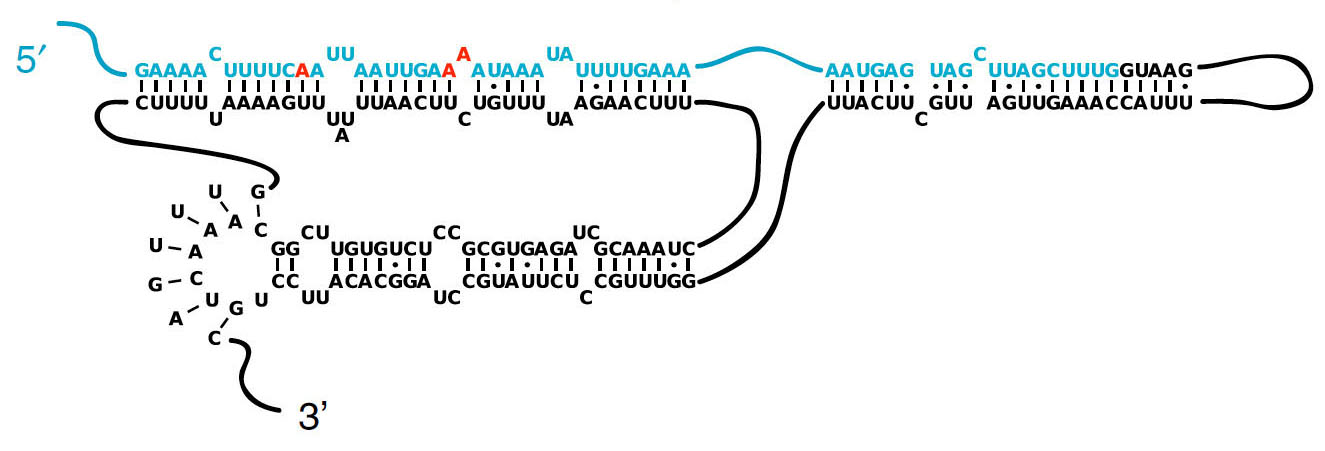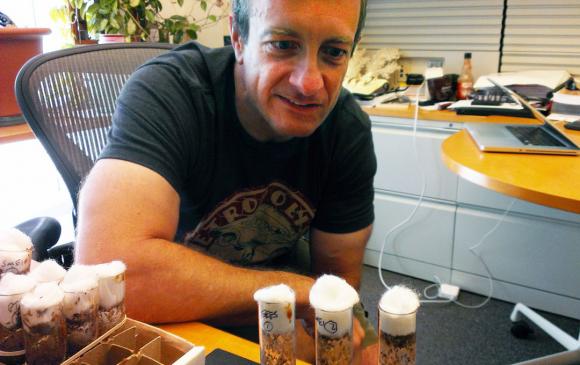PROVIDENCE, R.I. [Brown University] — RNA editing gives organisms a way to adapt the instructions that their DNA provides for making proteins. Few people would have described RNA editing as a simple process, but a new paper in Nature Communications demonstrates the process as more complex and difficult to predict than previously assumed. The study, done in living fruit flies, discovered two new mechanisms that govern editing in a key neurodevelopmental gene.
RNA editing is governed not only by sequences of RNA nucleotides (the letters A, C, G, and U) and corresponding structures near to the editing sites in the RNA molecule, as biologists had already suspected, but also by these newly described sequences and structures that are quite far away.
With new mechanisms also come new opportunities to influence RNA editing perhaps to combat disease, the Brown University researchers and their collaborators note.
Working in the model fruit fly gene para, which encodes expression of sodium channels in neurons, the biologists found two important sequences that give rise to these editing-altering mechanisms. Both exist in introns, which are sections genetic code that do not contain the actual instructions for making protein, but appear instead to have information about what to do with those instructions.
One new intronic sequence, the paper shows, forms a previously unknown 3-D structure that changes how the editing enzyme dADAR docks to an RNA molecule. From this alternate site, it edits a key nucleotide at particular site of para. The paper also describes another distant intronic sequence containing information about splicing, the process of cutting out and reassembling RNA into the full code for making a protein. With mutations, the scientists found, the sequence can be controlled like a tuning knob to either increase or decrease editing at the distant editing site.
“This is a cautionary tale where only looking for 2-D structures to predict where editing sites will be and how they will be regulated is going to be problematic,” said Robert Reenan, corresponding author of the paper and professor of biology in Brown’s Department of Molecular Biology, Cellular Biology and Biochemistry. “It looks like there is a lot more information contained in the introns as to the regulation of the editing than we previously thought.”
In living flies, Reenan and his team confirmed that altering RNA editing could have specific and stark physiological consequences. RNA editing, after all, can matter dramatically to the neurodevelopment of creatures ranging from fruit flies to people.
Discovering a ‘pseudoknot’

“Because the components of RNA editing are shared between animals as diverse as humans and insects, the fruit fly is an ideal model system in which to study the editing process,” said postdoctoral scholar and study lead author Leila Rieder. “Additionally, it is relatively easy to genetically engineer the fly to probe very deeply into genetic elements. From these studies in flies we learn about RNA editing in all animals.”
The first structure appears in the paper’s schematics as a huge arm-like offshoot from the RNA strand. At its tip is a ring-shaped sequence of just seven nucleotides and a complimentary outer ring of seven more. dADAR can dock there and perform its editing from a different position than it does when the structure does not form. Reenan and his co-authors call this structure a “pseudoknot.” Its presence proved essential for editing a particular nucleotide.
While the raw sequence of nucleotide letters was known, no one knew what it could form or what that meant. Computer programs that scientists use to make those structural predictions about RNA struggle with the third dimension, especially when thousands of nucleotide letters are involved.
Reenan, however, has focused on the para gene and its expression for almost 25 years. One day in 2008, when he was puzzling over para RNA in the old thesis of a former student, he noticed that this set of seven nucleotides had a perfectly complimentary sequence. It could have meant nothing, but what was important about these sequences is that they are found in every one of 37 different fruit fly species his lab has studied.
As he reasoned through potential implications of these highly conserved, matching sequences, he started searching the literature. He found a paper published by coincidence that very day by Yale researcher Anna Marie Pyle in Science. It described a structure found in an extremophilic bacterium that was remarkably similar, differing by only a few nucleotides.
That similar-but-not-identical bacterial structure gave him an opportunity to determine the role of the fly pseudoknot. Rieder used the bacterial structure to conduct a mutation-countermutation experiment. She replaced just the inner ring with the bacterial one and found that flies lost their ability to edit the target nucleotide. The same consequences occurred when she replaced just the outer ring with the bacterial one. But when she replaced both the outer and inner rings, editing was perfectly restored. The two matching sequences indeed worked together to enable editing.
“By putting in two different parts and restoring the editing interaction we showed that right there, at exactly that point, that interaction [between the two parts of the pseudoknot] are what has to occur for editing that site, ” Reenan said. “Nothing else will do,”
Splicing vs. editing
The other editing-tweaking sequence, called DCS in the paper, is similarly distant from the editing sites but works indirectly to govern editing. What it explicitly seems to control is splicing, perhaps by acting as a brake on that process. When splicing is highly active, the intron sequences (including the important elements) are cut out and no editing therefore occurs. When splicing is more laid back, the intron sequences remain, orchestrating editing, and dADAR can work on them longer.
In their experiments the researcher found that when they got rid of DCS, editing was substantially reduced. When they enhanced it with extra nucleotides it to make it longer and more stable, too much editing occurred. Flies with enhanced DCS ended up with serious health problems including death or paralysis.
Not surprisingly, flies left natural appeared to have a balance of splicing and editing somewhere in a happy medium of normal health.
On one hand the results suggest that biologists can’t predict RNA editing simply by analyzing the RNA near editing sites. On the other hand, they now have new mechanisms, albeit complex ones, that provide new opportunities for tuning the editing process.
“Our data on complex tertiary interactions could assist in the design of artificial editing substrates, enabling the co-option of endogenous ADAR enzymes as tools in specific RNA therapies,” the authors wrote in Nature Communications.
In addition to Reenan and Rieder, the paper’s other authors are Cynthia Staber of Stowers Institute for Medical Research in Kansas City, and Barry Hoopengardner Central Connecticut State University.
The National Science Foundation supported the research with a Graduate Research Fellowshop (DGE 0228243).

